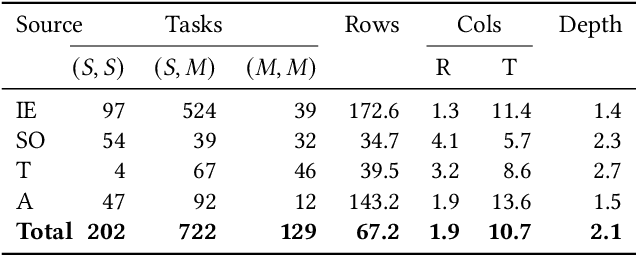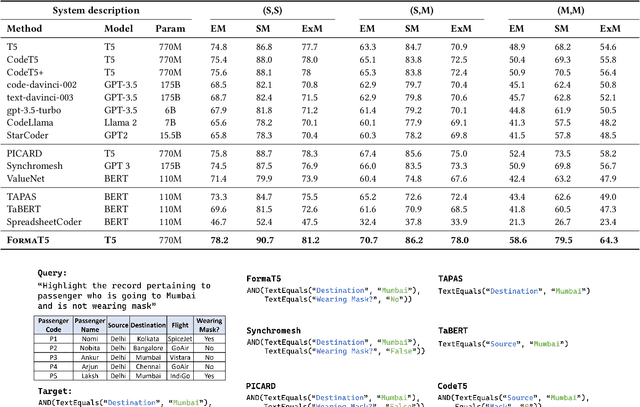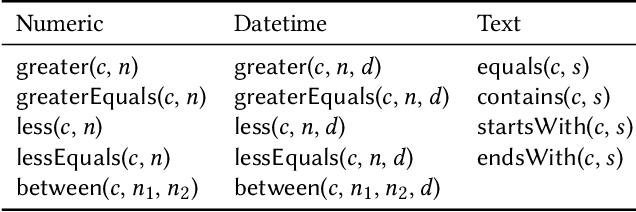Mukul Singh
Collaboration and Conflict between Humans and Language Models through the Lens of Game Theory
Sep 05, 2025Abstract:Language models are increasingly deployed in interactive online environments, from personal chat assistants to domain-specific agents, raising questions about their cooperative and competitive behavior in multi-party settings. While prior work has examined language model decision-making in isolated or short-term game-theoretic contexts, these studies often neglect long-horizon interactions, human-model collaboration, and the evolution of behavioral patterns over time. In this paper, we investigate the dynamics of language model behavior in the iterated prisoner's dilemma (IPD), a classical framework for studying cooperation and conflict. We pit model-based agents against a suite of 240 well-established classical strategies in an Axelrod-style tournament and find that language models achieve performance on par with, and in some cases exceeding, the best-known classical strategies. Behavioral analysis reveals that language models exhibit key properties associated with strong cooperative strategies - niceness, provocability, and generosity while also demonstrating rapid adaptability to changes in opponent strategy mid-game. In controlled "strategy switch" experiments, language models detect and respond to shifts within only a few rounds, rivaling or surpassing human adaptability. These results provide the first systematic characterization of long-term cooperative behaviors in language model agents, offering a foundation for future research into their role in more complex, mixed human-AI social environments.
An Empirical Study of Validating Synthetic Data for Formula Generation
Jul 15, 2024Abstract:Large language models (LLMs) can be leveraged to help with writing formulas in spreadsheets, but resources on these formulas are scarce, impacting both the base performance of pre-trained models and limiting the ability to fine-tune them. Given a corpus of formulas, we can use a(nother) model to generate synthetic natural language utterances for fine-tuning. However, it is important to validate whether the NL generated by the LLM is indeed accurate to be beneficial for fine-tuning. In this paper, we provide empirical results on the impact of validating these synthetic training examples with surrogate objectives that evaluate the accuracy of the synthetic annotations. We demonstrate that validation improves performance over raw data across four models (2 open and 2 closed weight). Interestingly, we show that although validation tends to prune more challenging examples, it increases the complexity of problems that models can solve after being fine-tuned on validated data.
Assessing GPT4-V on Structured Reasoning Tasks
Dec 13, 2023Abstract:Multi-modality promises to unlock further uses for large language models. Recently, the state-of-the-art language model GPT-4 was enhanced with vision capabilities. We carry out a prompting evaluation of GPT-4V and five other baselines on structured reasoning tasks, such as mathematical reasoning, visual data analysis, and code generation. We show that visual Chain-of-Thought, an extension of Chain-of-Thought to multi-modal LLMs, yields significant improvements over the vanilla model. We also present a categorized analysis of scenarios where these models perform well and where they struggle, highlighting challenges associated with coherent multimodal reasoning.
FormaT5: Abstention and Examples for Conditional Table Formatting with Natural Language
Nov 01, 2023



Abstract:Formatting is an important property in tables for visualization, presentation, and analysis. Spreadsheet software allows users to automatically format their tables by writing data-dependent conditional formatting (CF) rules. Writing such rules is often challenging for users as it requires them to understand and implement the underlying logic. We present FormaT5, a transformer-based model that can generate a CF rule given the target table and a natural language description of the desired formatting logic. We find that user descriptions for these tasks are often under-specified or ambiguous, making it harder for code generation systems to accurately learn the desired rule in a single step. To tackle this problem of under-specification and minimise argument errors, FormaT5 learns to predict placeholders though an abstention objective. These placeholders can then be filled by a second model or, when examples of rows that should be formatted are available, by a programming-by-example system. To evaluate FormaT5 on diverse and real scenarios, we create an extensive benchmark of 1053 CF tasks, containing real-world descriptions collected from four different sources. We release our benchmarks to encourage research in this area. Abstention and filling allow FormaT5 to outperform 8 different neural approaches on our benchmarks, both with and without examples. Our results illustrate the value of building domain-specific learning systems.
CodeFusion: A Pre-trained Diffusion Model for Code Generation
Nov 01, 2023



Abstract:Imagine a developer who can only change their last line of code, how often would they have to start writing a function from scratch before it is correct? Auto-regressive models for code generation from natural language have a similar limitation: they do not easily allow reconsidering earlier tokens generated. We introduce CodeFusion, a pre-trained diffusion code generation model that addresses this limitation by iteratively denoising a complete program conditioned on the encoded natural language. We evaluate CodeFusion on the task of natural language to code generation for Bash, Python, and Microsoft Excel conditional formatting (CF) rules. Experiments show that CodeFusion (75M parameters) performs on par with state-of-the-art auto-regressive systems (350M-175B parameters) in top-1 accuracy and outperforms them in top-3 and top-5 accuracy due to its better balance in diversity versus quality.
TST$^\mathrm{R}$: Target Similarity Tuning Meets the Real World
Oct 28, 2023Abstract:Target similarity tuning (TST) is a method of selecting relevant examples in natural language (NL) to code generation through large language models (LLMs) to improve performance. Its goal is to adapt a sentence embedding model to have the similarity between two NL inputs match the similarity between their associated code outputs. In this paper, we propose different methods to apply and improve TST in the real world. First, we replace the sentence transformer with embeddings from a larger model, which reduces sensitivity to the language distribution and thus provides more flexibility in synthetic generation of examples, and we train a tiny model that transforms these embeddings to a space where embedding similarity matches code similarity, which allows the model to remain a black box and only requires a few matrix multiplications at inference time. Second, we show how to efficiently select a smaller number of training examples to train the TST model. Third, we introduce a ranking-based evaluation for TST that does not require end-to-end code generation experiments, which can be expensive to perform.
InstructExcel: A Benchmark for Natural Language Instruction in Excel
Oct 23, 2023Abstract:With the evolution of Large Language Models (LLMs) we can solve increasingly more complex NLP tasks across various domains, including spreadsheets. This work investigates whether LLMs can generate code (Excel OfficeScripts, a TypeScript API for executing many tasks in Excel) that solves Excel specific tasks provided via natural language user instructions. To do so we introduce a new large-scale benchmark, InstructExcel, created by leveraging the 'Automate' feature in Excel to automatically generate OfficeScripts from users' actions. Our benchmark includes over 10k samples covering 170+ Excel operations across 2,000 publicly available Excel spreadsheets. Experiments across various zero-shot and few-shot settings show that InstructExcel is a hard benchmark for state of the art models like GPT-4. We observe that (1) using GPT-4 over GPT-3.5, (2) providing more in-context examples, and (3) dynamic prompting can help improve performance on this benchmark.
DataVinci: Learning Syntactic and Semantic String Repairs
Aug 21, 2023



Abstract:String data is common in real-world datasets: 67.6% of values in a sample of 1.8 million real Excel spreadsheets from the web were represented as text. Systems that successfully clean such string data can have a significant impact on real users. While prior work has explored errors in string data, proposed approaches have often been limited to error detection or require that the user provide annotations, examples, or constraints to fix the errors. Furthermore, these systems have focused independently on syntactic errors or semantic errors in strings, but ignore that strings often contain both syntactic and semantic substrings. We introduce DataVinci, a fully unsupervised string data error detection and repair system. DataVinci learns regular-expression-based patterns that cover a majority of values in a column and reports values that do not satisfy such patterns as data errors. DataVinci can automatically derive edits to the data error based on the majority patterns and constraints learned over other columns without the need for further user interaction. To handle strings with both syntactic and semantic substrings, DataVinci uses an LLM to abstract (and re-concretize) portions of strings that are semantic prior to learning majority patterns and deriving edits. Because not all data can result in majority patterns, DataVinci leverages execution information from an existing program (which reads the target data) to identify and correct data repairs that would not otherwise be identified. DataVinci outperforms 7 baselines on both error detection and repair when evaluated on 4 existing and new benchmarks.
Demonstration of CORNET: A System For Learning Spreadsheet Formatting Rules By Example
Aug 14, 2023



Abstract:Data management and analysis tasks are often carried out using spreadsheet software. A popular feature in most spreadsheet platforms is the ability to define data-dependent formatting rules. These rules can express actions such as "color red all entries in a column that are negative" or "bold all rows not containing error or failure." Unfortunately, users who want to exercise this functionality need to manually write these conditional formatting (CF) rules. We introduce CORNET, a system that automatically learns such conditional formatting rules from user examples. CORNET takes inspiration from inductive program synthesis and combines symbolic rule enumeration, based on semi-supervised clustering and iterative decision tree learning, with a neural ranker to produce accurate conditional formatting rules. In this demonstration, we show CORNET in action as a simple add-in to Microsoft Excel. After the user provides one or two formatted cells as examples, CORNET generates formatting rule suggestions for the user to apply to the spreadsheet.
From Words to Code: Harnessing Data for Program Synthesis from Natural Language
May 03, 2023



Abstract:Creating programs to correctly manipulate data is a difficult task, as the underlying programming languages and APIs can be challenging to learn for many users who are not skilled programmers. Large language models (LLMs) demonstrate remarkable potential for generating code from natural language, but in the data manipulation domain, apart from the natural language (NL) description of the intended task, we also have the dataset on which the task is to be performed, or the "data context". Existing approaches have utilized data context in a limited way by simply adding relevant information from the input data into the prompts sent to the LLM. In this work, we utilize the available input data to execute the candidate programs generated by the LLMs and gather their outputs. We introduce semantic reranking, a technique to rerank the programs generated by LLMs based on three signals coming the program outputs: (a) semantic filtering and well-formedness based score tuning: do programs even generate well-formed outputs, (b) semantic interleaving: how do the outputs from different candidates compare to each other, and (c) output-based score tuning: how do the outputs compare to outputs predicted for the same task. We provide theoretical justification for semantic interleaving. We also introduce temperature mixing, where we combine samples generated by LLMs using both high and low temperatures. We extensively evaluate our approach in three domains, namely databases (SQL), data science (Pandas) and business intelligence (Excel's Power Query M) on a variety of new and existing benchmarks. We observe substantial gains across domains, with improvements of up to 45% in top-1 accuracy and 34% in top-3 accuracy.
 Add to Chrome
Add to Chrome Add to Firefox
Add to Firefox Add to Edge
Add to Edge